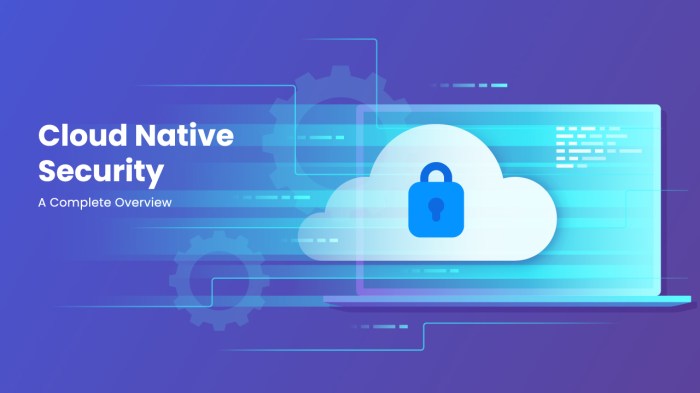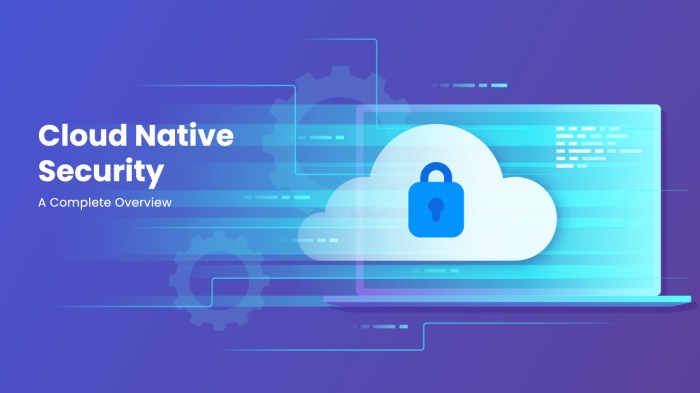ESG evolution of cloud native security is transforming how we approach digital infrastructure. It’s no longer just about robust technical defenses; it’s about aligning security practices with environmental, social, and governance principles. This in-depth exploration will examine the historical progression, key trends, and challenges in this evolving landscape.
This journey will cover the fundamental differences between traditional and cloud-native security approaches, examining the key drivers behind the evolution. We’ll delve into how cloud providers are integrating ESG considerations into their security offerings, highlighting the ethical implications and potential environmental impacts of different security measures.
Introduction to Cloud Native Security Evolution
Cloud native security is a crucial aspect of modern software development and deployment, addressing the unique challenges posed by cloud-based architectures. It focuses on securing applications and infrastructure throughout the entire lifecycle, from development and deployment to operation and management. This evolution stems from the shift in how applications are built, deployed, and managed in cloud environments.The traditional approach to security, often siloed and reactive, struggled to keep pace with the rapid changes and complexities introduced by cloud native development.
The move towards microservices, containerization, and declarative infrastructure management required a paradigm shift in security strategies. This evolution is characterized by a proactive, integrated, and dynamic approach to securing the cloud native ecosystem.
Definition of Cloud Native Security
Cloud native security encompasses a set of practices and technologies designed to protect applications and infrastructure deployed in cloud environments. It emphasizes the security of the entire application lifecycle, from design and development to deployment, operation, and management. This proactive approach contrasts with traditional security measures that are often reactive and focused on specific vulnerabilities rather than the overall security posture.
Historical Progression of Security Measures in Cloud Environments
Early cloud security was largely based on securing the underlying infrastructure. This involved measures such as network firewalls, intrusion detection systems, and access control lists. As cloud adoption increased, these measures became insufficient to address the evolving threats and complexities of cloud-based applications. The rise of containerization and microservices architectures further complicated the security landscape, demanding a more dynamic and integrated approach to security.
This evolved into a focus on securing the individual components and services of the application stack. The modern approach prioritizes securing the entire lifecycle, from development and deployment to operations and management.
Key Drivers Behind the Evolution of Cloud Native Security, Esg evolution of cloud native security
Several key factors have driven the evolution of cloud native security. These include the rise of microservices architectures, containerization technologies (like Docker), and the increasing complexity of cloud environments. The need for agility, scalability, and resilience in cloud-based applications also contributed to the demand for a more sophisticated security posture. Furthermore, the rise of sophisticated cyberattacks targeting cloud-based applications necessitates a more proactive and integrated security approach.
Key Differences Between Traditional and Cloud-Native Security Approaches
Traditional security approaches often relied on a reactive, perimeter-based model. Cloud native security, in contrast, adopts a proactive, integrated, and dynamic approach. Traditional methods focused on securing the infrastructure and applications independently, while cloud native security emphasizes securing the entire application lifecycle.
Comparison of Traditional and Cloud-Native Security Approaches
| Approach | Key Features | Strengths | Weaknesses |
|---|---|---|---|
| Traditional Security | Perimeter-based security, centralized security teams, reactive approach, focusing on infrastructure security. | Established frameworks, well-understood principles. | Difficult to scale with cloud environments, limited visibility into microservices and containers, slow response times to emerging threats. |
| Cloud Native Security | Integrated security throughout the application lifecycle, decentralized security teams, proactive approach, focusing on application and infrastructure security. | Enhanced visibility, faster response times, improved scalability, agility, and adaptability. | Requires specialized skills and tools, complex to implement and manage, integration challenges across different tools and services. |
ESG Considerations in Cloud Native Security: Esg Evolution Of Cloud Native Security
Cloud native applications, deployed on dynamic infrastructure, are rapidly transforming how businesses operate. However, this shift necessitates a careful consideration of Environmental, Social, and Governance (ESG) factors. Security measures, traditionally focused on technical aspects, now need to incorporate ESG principles to ensure responsible and sustainable practices. This evolution requires a holistic approach that balances security needs with ethical and environmental considerations.The increasing scrutiny on companies’ environmental impact, social responsibility, and governance structures is driving a demand for more transparent and accountable security practices.
Cloud providers are responding to this by integrating ESG principles into their offerings, and businesses must understand these considerations to leverage cloud native security effectively and ethically.
Key ESG Factors Influencing Cloud Native Security Decisions
ESG factors are intrinsically linked to cloud native security decisions. Environmental concerns, such as energy consumption and carbon footprint, are directly impacted by the hardware and software choices made for security infrastructure. Social factors, like data privacy and user rights, are crucial in the design and implementation of security measures. Governance aspects, such as compliance and accountability, shape the frameworks and policies that underpin cloud native security practices.
These factors are no longer peripheral; they are central to the decision-making process.
Cloud Providers’ Approach to ESG in Security Offerings
Cloud providers are increasingly incorporating ESG principles into their security offerings. This involves reducing the environmental impact of their infrastructure, adhering to strict data privacy regulations, and establishing transparent governance structures. Examples include using renewable energy sources in data centers, implementing efficient security tools, and offering compliance certifications. Some providers are even making sustainability metrics publicly available, allowing customers to assess the ESG footprint of their security solutions.
Ethical Considerations in Cloud Native Security Design
Ethical considerations are paramount in cloud native security design. The collection, storage, and use of user data must adhere to ethical principles of privacy and fairness. Security measures should not disproportionately affect certain user groups or create vulnerabilities that exploit biases. Transparency and accountability are essential, allowing users to understand how their data is handled and protected.
The evolving ESG standards are increasingly impacting cloud native security, demanding a more holistic approach. This evolution is fascinating, especially considering recent discussions surrounding security, like those found in the Loki news reviews interviews marvel disney plus articles. For example, loki news reviews interviews marvel disney plus highlight a range of perspectives on current events that mirror the growing need for responsible security practices in the cloud native space.
Ultimately, ESG principles are shaping how we approach cloud native security, demanding greater transparency and accountability in the future.
Furthermore, security measures should not compromise the fundamental human rights of individuals.
Environmental Impacts of Cloud Native Security Measures
The environmental impact of cloud native security measures is a growing concern. Certain security tools and techniques require significant computational resources, contributing to energy consumption and carbon emissions. For example, extensive encryption can increase the energy needed for processing. Similarly, the hardware used to support security infrastructure also has an environmental footprint. Careful consideration of these impacts, and the adoption of energy-efficient technologies and practices, is crucial.
Organizations must strive to minimize the environmental impact of their security solutions, while ensuring adequate protection.
Table: ESG Factors and their Implications for Cloud Native Security
| ESG Factor | Description | Impact on Security |
|---|---|---|
| Environmental | Energy consumption, carbon footprint, resource utilization | Security tools and infrastructure choices can impact energy consumption. Efficient tools and renewable energy sources are crucial. |
| Social | Data privacy, user rights, inclusivity, human rights | Security measures should respect data privacy and user rights. Avoid biased or discriminatory outcomes. |
| Governance | Compliance, accountability, transparency | Security practices must adhere to relevant regulations and standards. Transparency in data handling is vital. |
Emerging Security Trends and Technologies

The cloud native landscape is constantly evolving, demanding a dynamic approach to security. Emerging trends and technologies are reshaping how organizations secure their applications and data in this distributed, containerized environment. This necessitates a proactive and adaptive security posture, embracing innovation to mitigate emerging threats.The acceleration of cloud adoption, coupled with the increasing sophistication of cyberattacks, has propelled the need for innovative security solutions.
This includes leveraging AI/ML for automated threat detection and response, integrating DevSecOps for proactive security measures, and adopting zero trust principles to strengthen perimeter defenses.
AI/ML in Cloud Native Security
AI and machine learning (ML) are transforming cloud native security. AI-powered tools can analyze vast amounts of security data in real-time, identifying anomalies and potential threats with greater speed and accuracy than traditional methods. These tools can correlate events across different systems, predict potential attacks, and automate responses to known vulnerabilities. This automation dramatically reduces the time needed to identify and remediate threats, often before they cause significant damage.
For instance, AI-driven intrusion detection systems can recognize subtle patterns indicative of malicious activity in containerized environments, flagging suspicious behavior before it escalates.
DevSecOps Influence on Cloud Native Security
DevSecOps practices are fundamentally altering the approach to cloud native security. By integrating security into the software development lifecycle (SDLC), DevSecOps aims to build security into applications from the ground up. This proactive approach contrasts with traditional methods where security is often an afterthought. Security teams are working alongside development teams to ensure security standards are consistently enforced throughout the development process, automating security checks and incorporating vulnerability scanning into CI/CD pipelines.
This integrated approach minimizes security vulnerabilities before they reach production, reducing the risk of breaches and costly remediation efforts.
Zero Trust Security in Cloud Native Architectures
Zero trust security principles are increasingly influencing the design and implementation of cloud native architectures. The zero trust model operates under the principle of “never trust, always verify.” This means verifying the identity and authorization of every user, device, and application attempting access to resources, regardless of location. In a cloud native environment, this necessitates granular access control and dynamic policy enforcement.
Zero trust principles facilitate the secure management of microservices, containers, and distributed applications, minimizing the impact of breaches. A breach in one microservice will not automatically compromise the entire application.
The evolution of ESG factors in cloud native security is fascinating. It’s all about ensuring responsible and sustainable practices, and that includes the security of containerized applications. While I’m currently eyeing some great deals on Elfa shelves at the Container Store for spring cleaning, container store elfa shelves sale spring cleaning doesn’t change the need for robust security measures in the cloud.
Ultimately, the ESG considerations in cloud native security remain paramount, ensuring responsible and sustainable practices in the tech sector.
Emerging Security Technologies
The cloud native ecosystem is witnessing the emergence of various security technologies to address the specific challenges of this environment. These technologies are designed to enhance visibility, control, and protection across the entire application lifecycle.
| Technology | Description | Use Case |
|---|---|---|
| Serverless Function Security | Enhances security posture for serverless functions, ensuring secure access and execution of code. | Protecting API gateways and backend services in serverless environments. |
| Container Runtime Security | Provides security and compliance features within the container runtime environment. | Protecting container images and processes, ensuring isolation and preventing malicious activity within containers. |
| Network Segmentation and Micro-segmentation | Divides networks into smaller, isolated segments to limit the impact of security breaches. | Restricting access to sensitive resources, isolating workloads, and enforcing security policies in a micro-segmented network. |
| Cloud Native Application Protection Platforms (CNAPPs) | Provides a comprehensive security platform for cloud native applications. | Integrating security controls into the development, deployment, and operation of cloud native applications. |
Security Challenges and Mitigation Strategies
Cloud native applications, with their distributed nature and dynamic environments, introduce unique security challenges. Traditional security approaches often fall short in protecting these complex, rapidly evolving systems. Effective mitigation strategies require a deep understanding of these specific vulnerabilities and proactive measures to address them.
Major Security Challenges in Cloud Native Architectures
Cloud native architectures, characterized by microservices, containers, and orchestration platforms, present several security concerns. These include the increased attack surface due to the distributed nature of applications, the dynamic nature of deployments leading to constant changes, and the complex dependencies within the supply chain. Securing the interconnected components of a cloud native ecosystem is crucial to maintain the integrity and availability of the entire system.
Potential Vulnerabilities in Cloud Native Environments
Several vulnerabilities are inherent in cloud native environments. One significant concern is the use of containers, which, while offering portability, can introduce vulnerabilities if not properly secured. Image scanning and vulnerability management become crucial. Additionally, the dynamic nature of deployments can lead to misconfigurations or insecure deployments, making it imperative to have robust automated security scanning and monitoring.
The complex interplay of components and services in a cloud native system introduces vulnerabilities if not carefully managed.
Common Security Misconfigurations in Cloud Native Deployments
Misconfigurations are a major source of security vulnerabilities in cloud native deployments. Insecure access controls, inadequate logging and monitoring, and missing or outdated security patches can all lead to breaches. Improperly configured networking, especially in microservices deployments, can expose internal components to external threats. Failing to apply security best practices throughout the entire software development lifecycle can lead to significant risks.
Strategies to Mitigate Security Vulnerabilities and Risks
Effective mitigation strategies require a multi-faceted approach. Implementing comprehensive security scanning of container images, along with rigorous security testing throughout the development pipeline, is essential. Regular vulnerability assessments and penetration testing help identify and address potential weaknesses before they are exploited. Robust access control mechanisms, including least privilege principles, should be implemented across all components. Automated security monitoring tools can provide real-time insights into potential threats and anomalies.
Continuous security training for developers and operations teams is critical for fostering a security-conscious culture.
The evolution of ESG in cloud native security is fascinating, especially when you consider how crucial it is for organizations to prioritize these factors. For instance, Relias’s approach to enhancing patient care through unified network security, like relias elevates patient care with unified network security , highlights the importance of secure, reliable, and sustainable practices. Ultimately, the ESG framework will become increasingly critical as cloud native security continues to evolve.
Table Summarizing Security Challenges and Mitigation Strategies
| Challenge | Description | Mitigation Strategy |
|---|---|---|
| Container Image Vulnerabilities | Unpatched or vulnerable container images can be exploited by attackers. | Automated container image scanning, regular updates, and vulnerability management tools. |
| Dynamic Deployments and Misconfigurations | Rapid deployments can introduce misconfigurations, insecure configurations, or missing security measures. | Automated security scanning during deployments, configuration management tools, and security testing. |
| Supply Chain Vulnerabilities | Vulnerabilities in dependencies or components can be exploited. | Comprehensive security analysis of third-party components, secure build processes, and dependency management. |
| Inadequate Access Control | Lack of access controls and insufficient permissions can lead to unauthorized access. | Least privilege access controls, role-based access control (RBAC), and multi-factor authentication. |
| Lack of Monitoring and Logging | Insufficient logging and monitoring prevent the detection of anomalies and attacks. | Implement comprehensive logging, security information and event management (SIEM) tools, and real-time monitoring systems. |
Case Studies and Real-World Examples
Cloud native security is no longer a futuristic concept; it’s a crucial reality for businesses embracing modern architectures. Practical implementations showcase how companies are effectively integrating security into their cloud native strategies, often demonstrating significant improvements in efficiency and resilience. Understanding these real-world examples illuminates the potential benefits and challenges of this approach, offering valuable insights for organizations planning their own cloud native security journey.
Successful Cloud Native Security Implementations
Numerous companies have successfully integrated security into their cloud native environments. These implementations often involve adopting a proactive, layered approach that encompasses various security tools and practices. Security teams are increasingly focused on integrating security into the development lifecycle (DevSecOps) to prevent vulnerabilities from entering the codebase. For instance, implementing automated security scanning during the CI/CD pipeline can catch and address potential risks early on, saving time and resources.
Leveraging ESG Principles in Cloud Native Security
Companies are increasingly recognizing the importance of Environmental, Social, and Governance (ESG) principles in their cloud native security strategies. This integration often manifests in the selection of cloud providers with strong ESG records, commitment to sustainable practices, and a demonstrable focus on ethical data handling. For example, a company might choose a cloud provider known for its carbon-neutral data centers or its commitment to diversity and inclusion in its workforce.
Successful Use Cases of Emerging Security Trends
Several emerging security trends are proving valuable in cloud native environments. These include zero trust architectures, serverless security, and the adoption of AI/ML for threat detection. For example, a company might leverage zero trust to verify every user and device accessing critical systems, regardless of their location or network connection.
Impact of Security Measures on Different Industries
The impact of specific security measures varies across industries, reflecting the unique risks and compliance requirements of each sector. For instance, financial institutions might prioritize security measures that comply with stringent regulatory requirements, while healthcare organizations prioritize patient data protection.
Summary of Case Studies
| Industry | Use Case | Security Measures | Outcomes |
|---|---|---|---|
| E-commerce | Protecting customer data during online transactions | Implementing a multi-factor authentication system, encryption of sensitive data at rest and in transit, regular security audits | Increased customer trust, reduced data breaches, improved compliance with industry regulations |
| Financial Services | Securing financial transactions and sensitive data | Utilizing advanced threat detection systems, implementing micro-segmentation to isolate sensitive data, adopting a zero-trust security model | Reduced fraud, improved regulatory compliance, enhanced operational efficiency |
| Healthcare | Protecting patient data and maintaining HIPAA compliance | Implementing robust access controls, encrypting patient data, using AI-powered threat detection to identify suspicious activity, complying with stringent regulatory standards like HIPAA | Enhanced patient data security, minimized risk of data breaches, improved operational efficiency, and maintaining compliance with regulations. |
Future Directions and Predictions
The cloud native security landscape is rapidly evolving, driven by the continuous emergence of new technologies and the ever-increasing sophistication of cyber threats. Predicting the future is inherently challenging, but by analyzing current trends and considering emerging technologies, we can anticipate potential developments and prepare for the challenges ahead. This section Artikels future directions in cloud native security, focusing on ESG considerations and the implications of emerging technologies.Cloud native security will increasingly prioritize automation, AI, and machine learning to address the complexities of dynamic environments.
This shift will be critical for maintaining security posture in the face of ever-growing attack surfaces and increasingly sophisticated threats.
Future Trends in Cloud Native Security
The evolution of cloud native security will be characterized by several key trends. These trends are not isolated occurrences but rather interconnected, influencing each other and shaping the future of cloud native security.
- Enhanced Automation and Orchestration: Security operations will rely heavily on automation tools for tasks like vulnerability scanning, incident response, and threat detection. This will allow for faster reaction times and reduced human error in managing security in dynamic cloud environments. For example, automated patching and configuration management tools can significantly reduce the risk of known vulnerabilities.
- AI-Powered Threat Detection and Response: Artificial intelligence and machine learning will become more integral to security operations, enabling proactive threat detection and response. AI algorithms can analyze massive datasets of security events to identify patterns and anomalies indicative of malicious activity, leading to faster identification and mitigation of threats.
- Zero Trust Security Expansion: The zero trust model, which verifies every user and device, will continue to expand its application in cloud native environments. This approach will become a cornerstone of security strategies, extending beyond traditional perimeter-based security.
- Focus on DevSecOps Integration: Security will become deeply integrated into the software development lifecycle (DevSecOps). This means embedding security practices throughout the development process, ensuring security is not an afterthought but a fundamental aspect of every stage. For instance, automated security testing during the development pipeline will identify vulnerabilities earlier, minimizing the impact of breaches.
- Importance of Security Information and Event Management (SIEM): SIEM systems will evolve to handle the vast amounts of data generated by cloud native applications and infrastructure. Advanced analytics will be crucial for extracting actionable insights from this data to proactively identify and respond to threats.
ESG Considerations in Future Security Architectures
Security architectures must now incorporate ESG considerations to achieve long-term sustainability and resilience. This includes aligning security practices with environmental, social, and governance principles.
- Environmental Impact: Cloud native security solutions will need to be evaluated for their environmental footprint. Strategies for minimizing energy consumption and reducing carbon emissions associated with security operations will become crucial. For example, cloud providers are implementing more energy-efficient data centers to reduce their environmental impact.
- Social Impact: Ethical considerations and data privacy will play a more prominent role in cloud native security. Data security and responsible use of AI in security operations are key components to achieving this. For instance, cloud providers must comply with various data privacy regulations to protect user data.
- Governance Impact: Robust governance frameworks and compliance requirements will be essential for cloud native security operations. Transparent security practices and audit trails will be critical. For instance, organizations must comply with regulations like GDPR, HIPAA, and others.
Projected Evolution of Cloud Native Security
| Year | Trend | Impact | Potential Challenges |
|---|---|---|---|
| 2024-2025 | Increased automation of security tasks | Faster incident response, reduced human error | Skills gap in managing automated systems, potential for over-reliance on automation |
| 2026-2027 | AI-driven threat intelligence and proactive defense | Early threat detection and mitigation, reduced attack surface | Data bias in AI models, ethical considerations surrounding AI usage |
| 2028-2029 | Zero Trust security model becoming mainstream | Enhanced security posture, improved access control | Complexity of implementation, potential for increased operational overhead |
| 2030-2031 | Integration of ESG factors into security architectures | Sustainability and ethical operations | Balancing security with sustainability goals, measuring ESG impact |
Epilogue

In conclusion, the ESG evolution of cloud native security is a dynamic and multifaceted field. As cloud-native architectures continue to mature, we’ll see an increasing emphasis on integrating ESG factors into every stage of the security lifecycle. The future of cloud native security hinges on our ability to proactively address challenges and leverage emerging technologies to build a more secure, sustainable, and responsible digital future.




